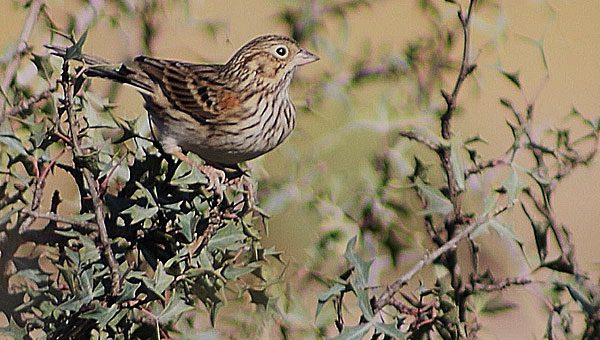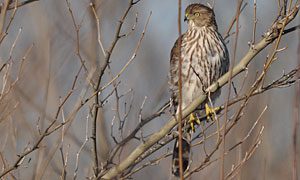Bird ID Skills: Color Pattern
Every bird you see is in your field guide somewhere.
Focus on patterns instead of trying to match every feather.
Western Tanager photo by Garret Burton April 20, 2009A picture – even a fleeting glimpse – can be worth a thousand words. As soon as you spot a bird, your eyes take in the overall pattern of light and dark. And if the light allows, you’ll probably glimpse the main colors as well. This is all you need to start your identification.
Use these quick glimpses to build a hunch about what your mystery bird is, even if you just saw it flash across a path and vanish into the underbrush. Then, if the bird is kind enough to hop back into view, you’ll know what else to look for to settle the identification.
Imagine a walk through a western forest, for example: A small, bright-yellow bird flits into the understory. Yellow immediately suggests a warbler (or the larger Western Tanager). Did you pick up a hint of grayness to the head? Or perhaps some glossy black? Just noticing that much can put you on track to identifying either a MacGillivray’s Warbler or a Wilson’s Warbler.
Some birds have very fine differences that take practice even to see at all. But don’t start looking for those details until you’ve used overall patterns to let the bird remind you what it is. Read on for a few tips about noticing patches of light and dark, the boldness of a bird’s markings, and making the most of outrageous colors.
Light and Dark
When you’re trying to make an ID, focus on overall color pattern instead of matching every detail to the pictures in your field guide. Remember that birds molt and their feathers wear. Their appearance can vary if the bird is old or young, or by how well it had been eating last time it molted. And of course, the light the bird is sitting in can have a huge effect on the colors you see.
At a distance and in very quick sightings, colors fade and all that’s left are light and dark. It helps to familiarize yourself with common patterns. For example, American White Pelicans are large white birds with black trailing edges to their wings. Snow Geese are similarly shaped and colored, but the black in their wings is confined to the wingtips.








Ring-necked Ducks and scaup are dark ducks with a pale patch on the side; Northern Shovelers are the opposite: light-bodied ducks with a dark patch on the side. Many birds are dark above and pale below – a widespread pattern in the animal world that helps avoid notice by predators. By reversing this pattern, male Bobolinks, with their dark underparts and light backs, look conspicuous even from all the way across a field.
Other birds seem to be trying to call attention to themselves by wearing bright patches of color in prominent places. Male Red-winged Blackbirds use their vivid shoulder patches to intimidate their rivals (notice how they cover up the patches when sneaking around off their territory). American Redstarts flick bright orange patches in their wings and tail, perhaps to scare insects out of their hiding places.
Many birds, including Dark-eyed Juncos, Spotted and Eastern towhees, American Robins, and several hummingbirds, flash white in the tail when they fly, possibly as a way of confusing predators. White flashes in the wings are common, too: look for them in Northern Mockingbirds, Acorn, Golden-fronted, and Red-bellied woodpeckers, Common and Lesser nighthawks, and Phainopeplas.
Bold and Faint
There are some confusing bird species that sit side by side in your field guide, wearing what seems like the exact same markings and defying you to identify them. Experienced birders can find clues to these tricky identifications by noticing how boldly or finely patterned their bird is. These differences can take a trained eye to detect, but the good news is that there’s a great trial case right outside at your backyard feeder.
House Finches are common backyard birds across most of North America. Much of the continent also gets visits from the very similar Purple Finch. Males of the two species are red on the head and chest and brown and streaky elsewhere. The females are both brown and streaky. So how do you tell them apart? Look at how strongly they’re marked.






Male House Finches tend to be boldly streaked down the flanks, whereas male Purple Finches are much paler and more diffusely streaked. Even the red is more distinct, and more confined to the head and breast, in a male House Finch. Male Purple Finches look washed all over, even on the back, in a paler raspberry red.
The all-brown females of these two species are an even better way to build your skills. The streaks on female House Finches are indistinct, brown on brown, with little actual white showing through. If a female Purple Finch lands next to it, she’ll stand out with crisply defined brown streaks against a white background, particularly on the head.
Once you’ve had some practice, these small differences can be very useful. Similar degrees in marking can be seen between the coarsely marked Song Sparrow and finely painted Lincoln’s Sparrow, and between immature Sharp-shinned and Cooper’s Hawks.










Outrageous Color
Some birds flash by in such splendid color that they can only be one of a very few things.
These are some of the gratuitous pleasures of being a bird watcher: a blazing-orange male oriole; a scarlet cardinal or tanager; a Mountain Bluebird as pale as a winter sky. All-out assaults on your eyes like the Painted Bunting and Green Jay, or a Gulf Coast oak tree dripping with spring warblers.
Colors like these are high on the list of reasons many of us started bird watching – you probably don’t need a tip from us to notice them. But we do encourage you to use those colors for a near-instant identification. Then sit back and enjoy the view.
All About Birds
is a free resource
Available for everyone,
funded by donors like you
American Kestrel by Blair Dudeck / Macaulay Library
